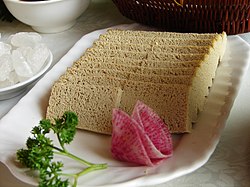
A meat substitute, also called a meat analogue, approximates certain aesthetic qualities (primarily texture, flavor and appearance) or chemical characteristics of a specific meat. Substitutes are often based on soybeans (such as tofu and tempeh), gluten, or peas. [1] Whole legumes are often used as a protein source in vegetarian dishes, but are not listed here.






